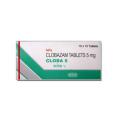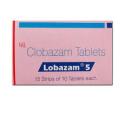Home / Categories / CLOPSY-5MG

CLOPSY-5MG
(10X10)
CLOBAZAM-5MG
BENZODIAZEPINES
MAGNUS PHARMA-PSYNO DIVISION
Product Details
CLOBAZAM
Indication
For treatment and management of epilepsy and seizures associated with Lennox-Gastaut syndrome, a difficult-to-treat form of childhood epilepsy.
Associated Conditions
- Epilepsies
Pharmacodynamics
Similar to other benzodiazepines, clobazam binds to the interface of the α and γ2-subunit of the GABA-A receptor. However, it is considered a partial agonist to GABA-A receptors which sets clobazam apart from 1,4-benzodiazepines which are full agonist. The significance of this difference is that one may experience less sedation with clobazam than with other benzodiazepines. Unlike the endogenous GABA ligand, clobazam binds allosterically to the GABA receptor to increase the frequency of the chloride channel opening and membrane permeability to chloride ions. Pharmacodynamic tolerance has been demonstrated in animal models.
Mechanism of action
Clobazam binds at distinct binding sites associated with the chloride ionopore at the post-synaptic GABA receptor. These GABA receptors are in various locations in the CNS (limbic, reticular formation) and clobazam increases the duration of time for which the chloride ionopore is open. As a result, hyper polarization and stabilization of the membrane occur as the post-synaptic inhibitory effect of GABA is enhanced.
TARGETACTIONSORGANISMAGABA-A receptor (anion channel)
positive allosteric modulator
Human
Absorption
After oral administration of clobazam, it is almost completely absorbed (87% of dose). Bioavailability relative to solution was almost at 100%. Food does not affect absorption. Tmax = 1-3 hours.
Volume of distribution
Vdss = 100 L. This high volume of distribution suggests extensive distribution to body tissues.
Protein binding
Clobazam is the primary circulating entity in the serum and is highly protein-bound (80-90%).
Metabolism
Clobazam is extensively metabolized in the liver via N-demethylation and hydroxylation. Clobazam has two major metabolites: N-desmethylclobazam (norclobazam) and 4'-hydroxyclobazam, the former of which is active. Norclobazam is one-fourth the potency of clobazam. The main enzyme that facilitates the process of N-demethylation is CYP3A4, and to a lesser extent by CYP2C19 and CYP2B6. Norclobazam itself is also metabolized via hydroxylation, primarily by CYP2C19. The formation of 4'-hydroxyclobazam is facilitated by CYP2C18 and CYP2C19. A factor in determining extent of metabolism is the genetic profile of the individual patient as CYP2C19 is a polymorphic enzyme.
- Clobazam
norclobazam - Clobazam
4'-hydroxyclobazam
Route of elimination
Clobazam is eliminated via the urine (~94%) as metabolites.
Half life
The mean elimination half life of an oral dose of clobazam 40 mg is 32 hours. It's main metabolite, norclobazam, as a half life of 57 hours. The half life in adult patients with epilepsy are higher than those that are healthy.
Clearance
Median estimated clearance = 2.49 L/h
Toxicity
The most common adverse effects include somnolence, pyrexia, upper respiratory tract infection, and lethargy.
Affected organisms
- Humans and other mammals
Pathways
Not Available
SOURCE: DRUGBANK









